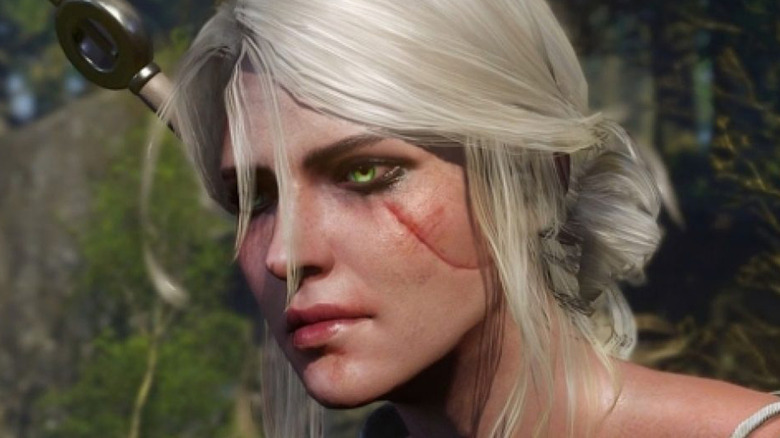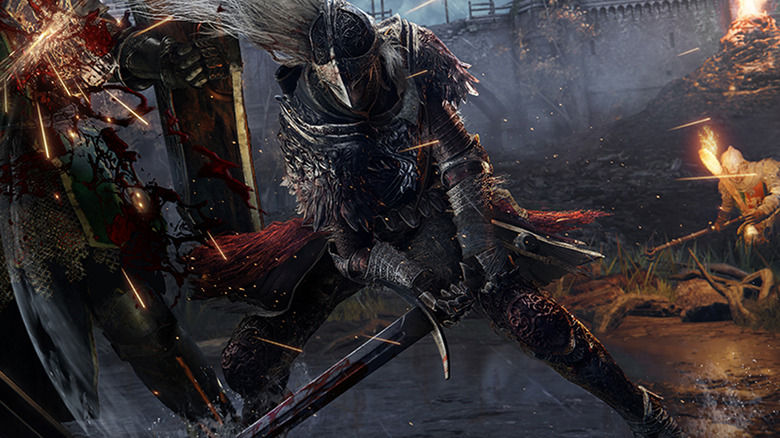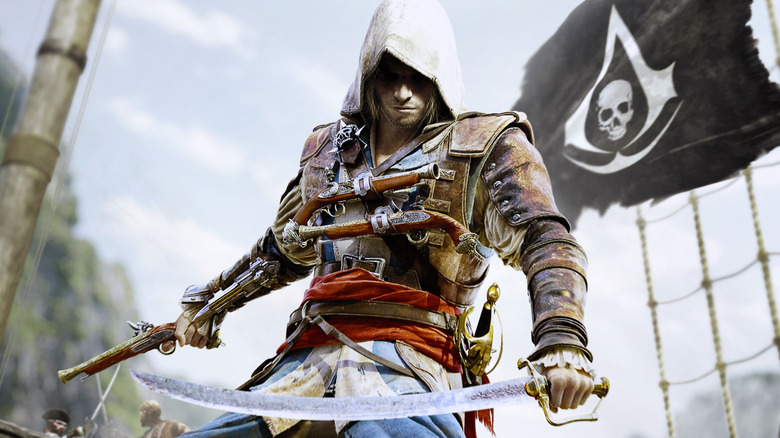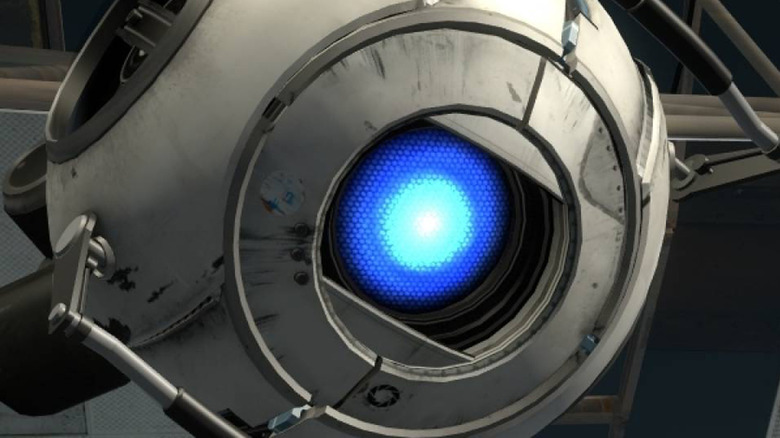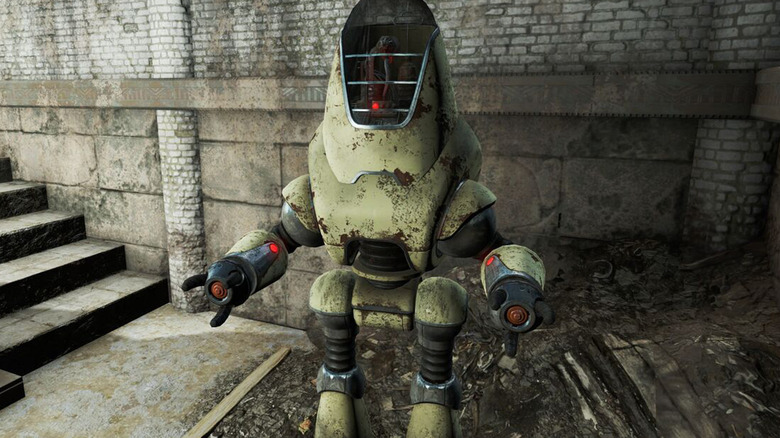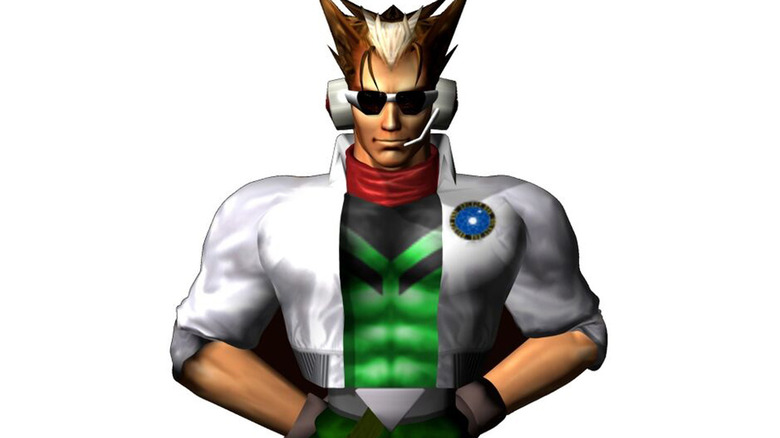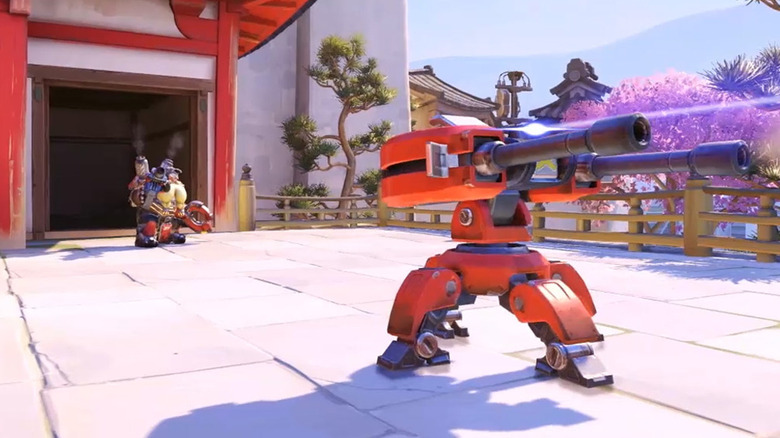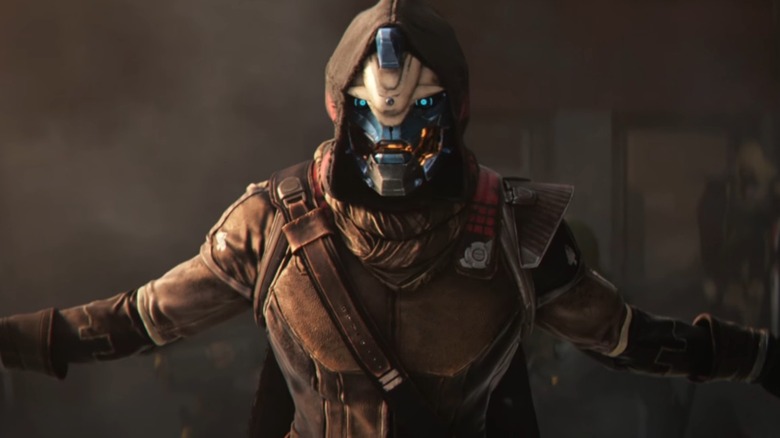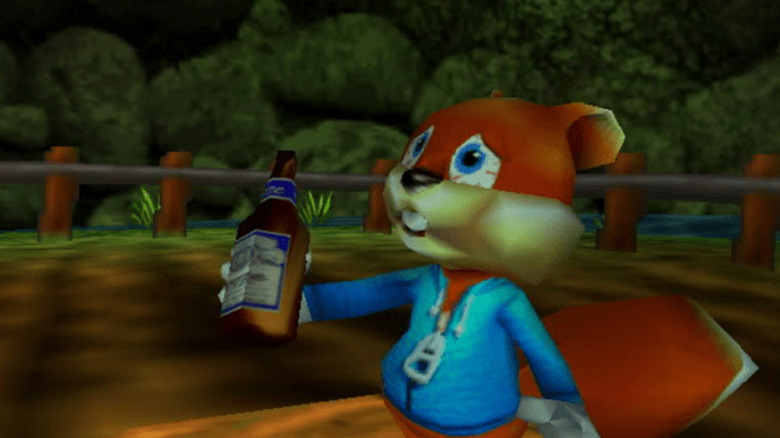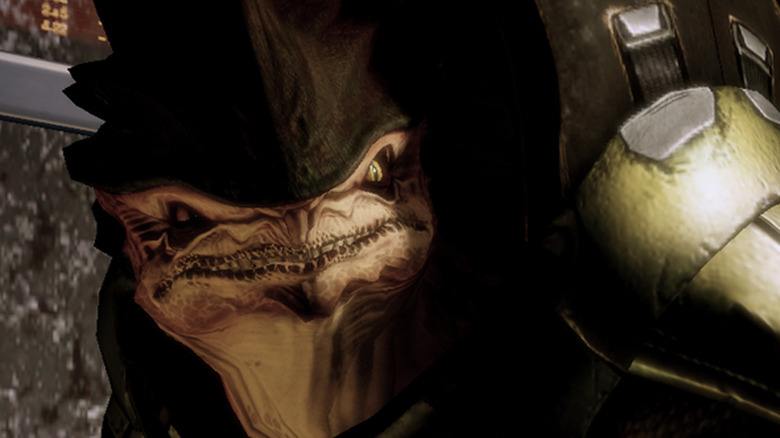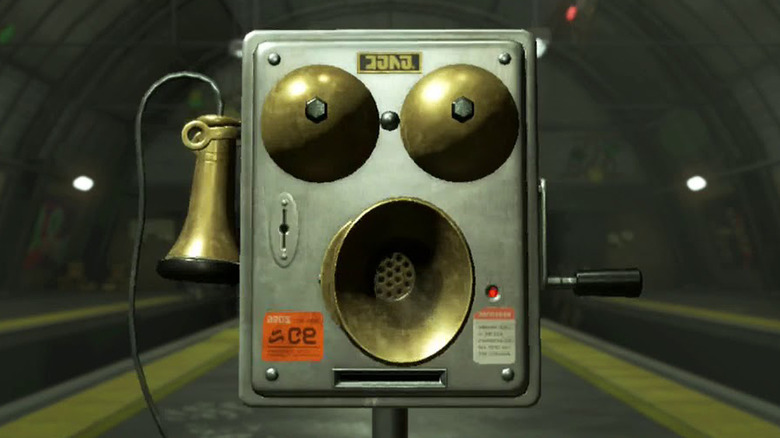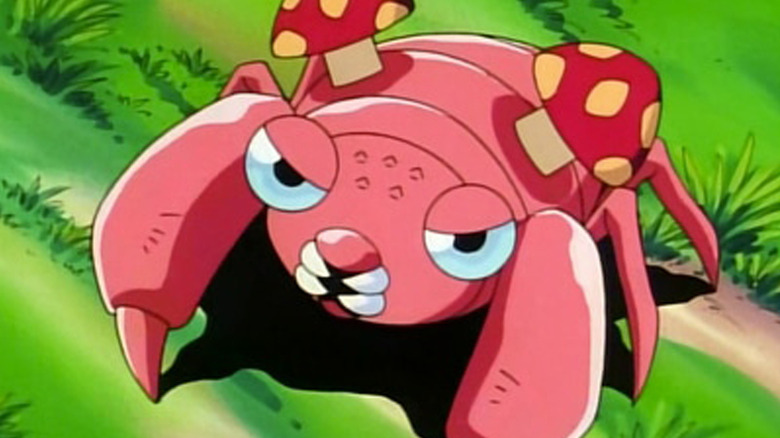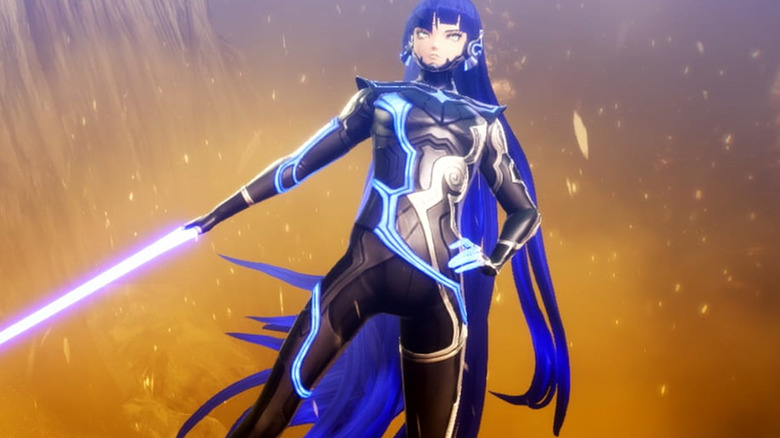Fan Theories That Put These Games In The Same Universe
Much of the hype surrounding "Cyberpunk 2077" prior to its release was likely a direct result of the acclaim received by developer CD Projekt Red for its previous project, "The Witcher 3: Wild Hunt." And of course, there were the fan theories.
In "The Witcher 3," Ciri, one of the game's principal supporting characters, mentions traveling to an alternate dimension in which people have metal implanted in their heads, fight each other with guns, and travel in flying cars. Ciri is seemingly describing Night City, the central location in "Cyberpunk 2077." Moreover, following the release of "Cyberpunk 2077," players found a bird in a late game quest that appeared to symbolize Ciri, which seemed to further connect the two CDPR games.
While it seemed like Ciri had visited the universe in which "Cyberpunk 2077" takes place, and possibly even brought a bird with her, the two games are not yet officially connected. In fact, in 2018, "Cyberpunk 2077" director Adam Badowski outright denied that the two games share a multiverse (via Polygon).
Despite the fact that this theory was shot down, it's still an intriguing element of both game's universes. It's often due to links like this one, existing in a gray area between easter egg and canon, that fans sometimes theorize how the worlds of disparate gaming franchises might somehow, despite all odds, be connected. Here are some of those theories.
Dark Souls and Elden Ring
On June 10, 2021, FromSoftware released the first substantial gameplay trailer for "Elden Ring," the "Dark Souls" developer's collaboration with "A Song of Ice and Fire" author George R. R. Martin. A number of longtime FromSoftware fans immediately noticed similarities between its game world and that of "Dark Souls." These similarities became a frequent source of discussion online, garnering coverage from Forbes among other outlets.
Some fans, however, believe that the similarities between the two games are not a coincidence, but rather the result of a shared universe. In a piece for Den of Geek, author Matthew Byrd pointed out that a location shown in the June 10 "Elden Ring" trailer resembles the city of Anor Londo from "Dark Souls." Furthermore, the trailer's narrator sounds similar to a painter character from "Dark Souls 3" that mentions working on creating a new world. According to Byrd's theory, then, the painter from "Dark Souls 3" may have designed the world of "Elden Ring" himself.
It's worth noting that George R. R. Martin confusingly referred to "Elden Ring" as a sequel to "Dark Souls," though it's likely he simply meant "sequel" in a broader sense of the word.
Assassin's Creed, Watch Dogs, and Far Cry
If nothing else, Ubisoft knows how to design a big game. The massive (and lengthy) "Assassin's Creed: Valhalla," for example, was the second-best selling game of November 2020, behind only the latest in the ever-successful "Call of Duty" franchise.
According to some fans, however, the sizable game worlds of "Assassin's Creed" and fellow Ubisoft hits "Watch Dogs" and "Far Cry" are all connected. This theory hinges upon one tangible piece of evidence: all games include reference to a company called Abstergo.
A post to the FanTheories subreddit argues that an Abstergo computer in "Assassin's Creed IV: Black Flag" containing references to plot elements from "Watch Dogs" is evidence enough of a linked world. The presence of Abstergo likewise links "Far Cry" into this shared universe. This Redditor argued that the remote ad rural locations of the "Far Cry" games are simply too far away to have access to certain technologies, but the distance allows them to still neatly can co-exist with the technologically advanced worlds of "Assassin's Creed" and "Watch Dogs."
(Almost) All Valve games
Valve is perhaps best known as the developer of mega-hits like "Half-Life" and "Portal," in addition to their respective sequels. In fact, those two franchises canonically take place in a shared universe, which is revealed by the presence of the Borealis in "Portal 2," a ship that first appeared in "Half-Life 2."
Reddit user GuyWithTooMuchTime, however, argues that "Half-Life" and "Portal" aren't the only ones in this fictional world — all Valve games could share the same universe. They begin by explaining the inclusion of "Day of Defeat" and "Team Fortress Classic" in their Valve canon as simply existing as chronicles of historic wars. They then argue that "Counter-Strike" takes place in the '90s and "Left 4 Dead" during a zombie outbreak that might have occurred in the wake of the mad science gone awry seen in "Half-Life" and "Portal."
This theory is supported by a number of references catalogued by Reddit user MOTZI_SerialGamer. "Counter-Strike: Global Offensive," for example, includes the presence of the all-important Borealis ship. They also liken Grey Mann from "Team Fortress 2" to the similarly-named G-Man from "Half-Life," implying some sort of relationship between the two mysterious villains. Finally, like GuyWithTooMuchTime, this Redditor suggests that the Combine from "Half-Life" was instrumental in fighting off the zombie apocalypse in "Left 4 Dead."
Elder Scrolls, Fallout, and Starfield
While Bethesda's "Elder Scrolls" and "Fallout" don't officially take place in the same universe, some fans believe the two game worlds to be linked by a plant in "Fallout 4" that resembles an item from "The Elder Scrolls V: Skyrim." In a 2017 interview with GameSpot, Bethesda's Pete Hines slammed this theory and declared it to be false. However, fans have continued to dig into the possibilities.
In a post to the FanTheories subreddit, user Fallonite argues that the "Fallout" franchise takes place after "Elder Scrolls," following a mass extinction event. While their post is pure conjecture meant to explain the presence of Nirnroot in both series, they suggest that wizards in the "Elder Scrolls" timeline pulled their moon into the Earth, thus ending all life millenia prior to the development of the civilizations of that would eventually be destroyed before "Fallout."
A teaser for Bethesda's next franchise, "Starfield," which aired during Xbox's E3 2021 showcase, includes what some fans believe is a map of Tamriel, the continent on which the "Elder Scrolls" games take place. While this is likely an easter egg (if that) meant to build hype for the next "Elder Scrolls" game, the inclusion of a map of Tamriel in a canonical "Starfield" ship would still seem to physically link all three Bethesda franchises.
Star Fox, F-Zero, and Super Mario RPG
The "F-Zero" series, from which "Super Smash Bros." mainstay Captain Falcon originates, features a pilot of one of its futuristic vehicles named James McCloud. His appearance, as well as that of his vehicle, closely resemble those of "Star Fox" protagonist Fox McCloud and his signature Arwing spaceship.
In a post to the StarFox-Online.net forums, user Linkiriow suggests that those similarities could theoretically transcend homage and mark an interconnected universe. Their theory hinges upon the fact that, in one ending of the Nintendo DS game "Star Fox Command," Fox and Falco decide to rework their Arwings into vehicles capable of competing in something called the G-Zero Grand Prix. In all likelihood, these are simply mutual winks from one franchise to another, but Linkiriow points to the near-identical appearances of James and Fox McCloud as evidence that F-Zero takes place canonically after "Star Fox Command" — Fox just somehow made himself look more human, apparently.
Furthermore, Likiriow's post mentions that a location in "Super Mario RPG" includes an Arwing, as well as the Blue Falcon and Fire Stingray vehicles from "F-Zero." Using fan theory logic, this can be interpreted as evidence that both series are linked to the world of "Super Mario RPG," as well.
Overwatch and Team Fortress 2
When Blizzard's flagship FPS "Overwatch" was first released, there was little else on the market that combined MOBA-like character classes with first-person aim-intensive multiplayer gameplay. "Overwatch" wasn't without precedent, however. Arguably its closest cousin and primary inspiration is "Team Fortress 2." While there's no concrete evidence to link these two games canonically, some fans have tried their best, mainly due to the fact that they resemble one another.
By the estimation of Reddit user VICI_44, since the Medic from "Team Fortress 2" once bargained with the devil for an extended lifespan, he likely lived well beyond the 1970s timeline of "Team Fortress 2." During his twilight years, they suggest he may have left behind his medical technology to none other than Dr. Zeigler, a.k.a. Mercy of "Overwatch" fame. Mercy's healing staff notably resembles the Medic's beam-based healing mechanism. Since "Overwatch" obviously takes place after "Team Fortress 2" timeline-wise, this theory posits that Mercy's staff is a more advanced version of the Medic's healing tool.
In a post to the official Blizzard forums, user Micah76 similarly suggested that the turrets used by "Overwatch" hero Torbjörn could be directly inspired by schematics created by the Engineer in "Team Fortress 2."
Marathon, Halo, and Destiny
Bungie has become well-known among gamers as the developer of both the "Halo" and "Destiny" franchises. Before "Halo," however, Bungie already had a number of games to its name, including a "Pong" clone for Mac OS called "Gnop" and sci-fi FPS "Marathon."
Reddit user anotherandomer has theorized that all three of Bungie's sci-fi FPS series take place in a shared universe. One piece of evidence they cite is a poster in "Halo 3: ODST" by a fictional company called Askon that closely resembles the "Destiny" logo. This may in fact suggest that Askon was instrumental in developing the space-bound society featured in "Destiny."
Furthermore, in "Halo: Combat Evolved," Navy tactician Captain Jacob Keyes wears an emblem taken directly from "Marathon." This is arguably evidence, then, that the perilous events of "Marathon" have been memorialized by the military by the time the events of "Halo" occur. This theory thus suggests that the events of "Marathon" were followed by those of "Halo" and then "Destiny," progressing from a nearer future in "Marathon" to the far-flung future of the "Destiny" series.
Mario, Banjo-Kazooie, and Conker's Bad Fur Day
"Banjo-Kazooie" and "Conker's Bad Fur Day" are both 3D platformers developed by Rare for the Nintendo 64. While the two titles share a few gameplay similarities, they have never been officially confirmed as sharing a canonical universe. In a post to the FanTheories subreddit, however, user korja78 attempts to prove that not only do Rare's two flagship N64 franchises take place in a shared world, but that Mario also exists in that universe.
Their theory hinges upon the existence of "Diddy Kong Racing," a "Mario Kart" spinoff featuring "Donkey Kong" characters. At the time, Rare was in charge of the Donkey Kong IP, serving as the developer of both "Diddy Kong Racing" and "Donkey Kong 64." As a result, Rare protagonists Banjo and Conker were included in the roster of playable characters in "Diddy Kong Racing."
Even though these characters have never interacted in other circumstances, the fact that Conker and Banjo could meet in the world of "Diddy Kong Racing," korja78 argues, means that the two games must share a universe. Mario is also tangentially connected to the Rare-verse by the fact that "Mario" and "Donkey Kong" characters have a long history of appearing alongside one another, dating all back to Mario's debut in the original "Donkey Kong."
Mass Effect, Dragon Age, and The Sims
In a 2014 piece for Kotaku, Patricia Hernandez outlined how the worlds of BioWare's sci-fi series, "Mass Effect," and its flagship fantasy franchise, "Dragon Age," may be connected to one another.
Chief among her evidence is the mounted head of a Krogan, an alien species in "Mass Effect," which appears in "Dragon Age Inquisition." Like many suggestions of shared game universes, the truth behind the Krogan head is that it's likely a simple easter egg. Taken at face value, however, it all-but-confirms that "Mass Effect" and "Dragon Age" share a world, especially when one considers the fact that the Krogan are unique to "Mass Effect" lore. "Mass Effect 2" likewise includes a statue of an ogre from "Dragon Age," which is but one among numerous nods from one series to the other.
"The Sims" enters the picture due to the inclusion of a time travel machine in "The Sims 3." Reddit user sheetskees describes how using it to visit the future reveals to players a crowd of people cheering for a hero named Shepard, which is the name of the protagonist in "Mass Effect." Presuming this to be the same Shepard effectively links all three series.
Mario and Splatoon
Debuting in 2015, "Splatoon" is one of the newest of Nintendo's first-party franchises. That said, it's since become a Nintendo mainstay, with an Inkling from "Splatoon" making it onto the initial roster of characters for "Super Smash Bros. Ultimate."
In a post to the "Splatoon" subreddit, user ScorelessPine argues that "Splatoon 2: Octo Expansion" includes evidence of a shared world with the "Super Mario Bros." series. Throughout "Octo Expansion," the player character communicates with an artificial intelligence named Telephone, which was designed by an anonymous human professor to warn future civilizations of certain factors that led to humanity's extinction.
ScorelessPine points out that the design of the physical phone that the Telephone AI inhabits resembles Mario's FLUDD device, which the famous plumber used to clean graffiti in "Super Mario Sunshine." Furthermore, ink attacks used by Telephone and some of the minions it commands likewise resemble the paint from "Super Mario Sunshine." Interpreting this as evidence the two games are connected, then, would make the anonymous creator of Telephone none other than recurring "Mario" character Professor E. Gadd, who invented the FLUDD and very well may be attempting to warn the future squid civilization in "Splatoon" of the mistakes committed by humanity.
Pokemon and The Last of Us
The very idea that the cartoony monster-catching "Pokemon" franchise and the gritty, mature "Last of Us" series could share a universe might sound far-fetched, even by fan theory standards. That said, some fans have attempted to prove this, driven by one curious connection between both games.
In a post on the FanTheories subreddit, user Calcium-Sama points out how the Pokemon Paras and its evolution Parasect bear cordyceps on their backs. Cordyceps is a real-life fungus that takes over the body of living caterpillars (via Utah State University). In Pokemon canon, the fungus that grows on the backs of both Paras and Parasect is the caterpillar fungus, Ophiocordyceps sinensis.
The virus in "The Last of Us" that transforms sentient humans into bloodthirsty zombies is likewise a mutation of the real-life cordyceps fungus. "Pokemon," then, is the only major franchise to include a larger mutated variety of the cordyceps virus other than "The Last of Us." By the estimation of Calcium-Sama (and writer Megan Gingerich, who proposed a similar theory at Game Rant) the cordyceps-baring Pokemon Paras and Parasect could arguably be a precursor to the virus that ended civilization in "The Last of Us."
ALL video games
With so many fan theories connecting one video game to another through the most tenuous of links, it was all but inevitable that one pioneering individual would attempt to connect every single video game in a single, overarching fan theory.
User Starkstar502 shared their findings, appropriately, to the FanTheories subreddit in a two-part post. They begin with Mario, who can already be connected to "Banjo-Kazooie," "Conker's Bad Fur Day" and "Splatoon," as well as many others. From there, Starkstar502 finds tiny links that connect Mario to a number of other Nintendo franchises, like "Pokemon" and "The Legend of Zelda." That means that all of the games that those games have been connected to ("Pokemon" to "The Last of Us," etc.) can then be folded into the theory.
Some ensuing highlights include the linking of "Zelda" to "Tetris" — since Link outright appears in a "Tetris" game — and "Metroid" to "StarCraft," thanks to the appearance of the former franchise's signature Metroid enemy in the second "StarCraft" game. With Nintendo as Starkstar502's starting point, they're then able to connect franchises as diverse as "Shin Megami Tensei" and "Star Wars."
Though their lengthy post doesn't name every single video game ever made, their brand of logic provides a groundwork through which virtually any other video game imaginable might be looped into this unified theory.

